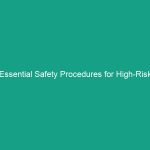Good Morning Team!
Today, we’re diving into an essential topic for our Workplace Safety: Critical De-energization Verification. This practice is vital for ensuring that electrical circuits are dead before Maintenance or troubleshooting begins. It’s not just a routine; it’s a crucial step that protects us from potential Hazards and ensures that we can work safely.
Understanding Critical De-energization Verification
Critical De-energization Verification refers to the systematic process of confirming that electrical circuits are completely de-energized before any work is performed. This verification is integral to our Safety protocols and has a significant impact on our daily operations. Misunderstandings about this process can lead to severe injuries or even fatalities.
Many believe that simply turning off a switch is enough. However, this is a misconception. It is vital to understand that it is not just about turning off the circuit but also verifying that it is indeed dead and safe to work on.
Key Hazards, Risks, and Safety Considerations
When working with electrical systems, there are specific hazards that we need to consider:
- Electrical Shock: One of the most immediate dangers when circuits are not properly de-energized. This can lead to serious injuries or even death.
- Arc Flash: If the circuit is inadvertently energized, an arc flash can occur, resulting in Burns or other severe injuries.
- Equipment Damage: Working on live circuits can damage sensitive equipment, leading to costly repairs and downtime.
Real-world consequences of ignoring safety protocols include accidents that can lead to injuries, legal penalties, and increased insurance costs. Each of us has a role in preventing these outcomes.
Best Practices, Procedures, & Actionable Advice
To ensure that we are practicing effective Critical De-energization Verification, follow these key Procedures:
- Notify All Affected Employees: Before beginning any de-energization process, inform all employees who might be affected by the work.
- Turn Off the Power: Use the appropriate switch or circuit breaker to turn off the power supply to the circuit.
- Use Testing Equipment: Employ a properly rated voltage tester to ensure that the circuit is dead. Test on multiple points to verify.
- Lockout/Tagout (LOTO): Implement LOTO procedures to prevent accidental re-energization. Place a lock on the circuit breaker or switch and tag it to indicate that work is being performed.
- Double-Check: After locking out, double-check the voltage test results to confirm that there is no electrical current present.
For example, in a past incident, a technician assumed a circuit was dead after turning off the power. Unfortunately, he did not verify with a voltage tester, leading to an electrical shock that could have been avoided with proper de-energization verification.
Regulations, Standards, and Compliance
Compliance with safety Regulations is crucial for protecting our team and maintaining a safe work Environment. Relevant Standards include:
- OSHA 1910.333: This standard mandates that employees must be trained and understand the hazards associated with working on electrical equipment.
- NFPA 70E: This standard focuses on Electrical Safety in the workplace, emphasizing the importance of de-energization verification.
Understanding and adhering to these regulations is not just about following the law; it’s about ensuring your safety and the safety of your coworkers.
Employee Engagement & Discussion
Let’s take a moment to reflect on our practices. What safety challenges have you encountered related to electrical work? Have you ever faced a situation where you were unsure whether a circuit was truly dead? Discussing these experiences can help us all learn and improve our safety practices.
Conclusion & Key Takeaways
In summary, Critical De-energization Verification is a fundamental safety practice that we must prioritize. Always ensure circuits are dead before beginning any work, utilize proper testing equipment, and follow lockout/tagout procedures to maintain a safe working environment.
Remember, safety is everyone’s responsibility. By applying these practices, we not only protect ourselves but also our teammates. Thank you for your attention and commitment to safety. Let’s continue to look out for one another and make our workplace a safe environment for all!


